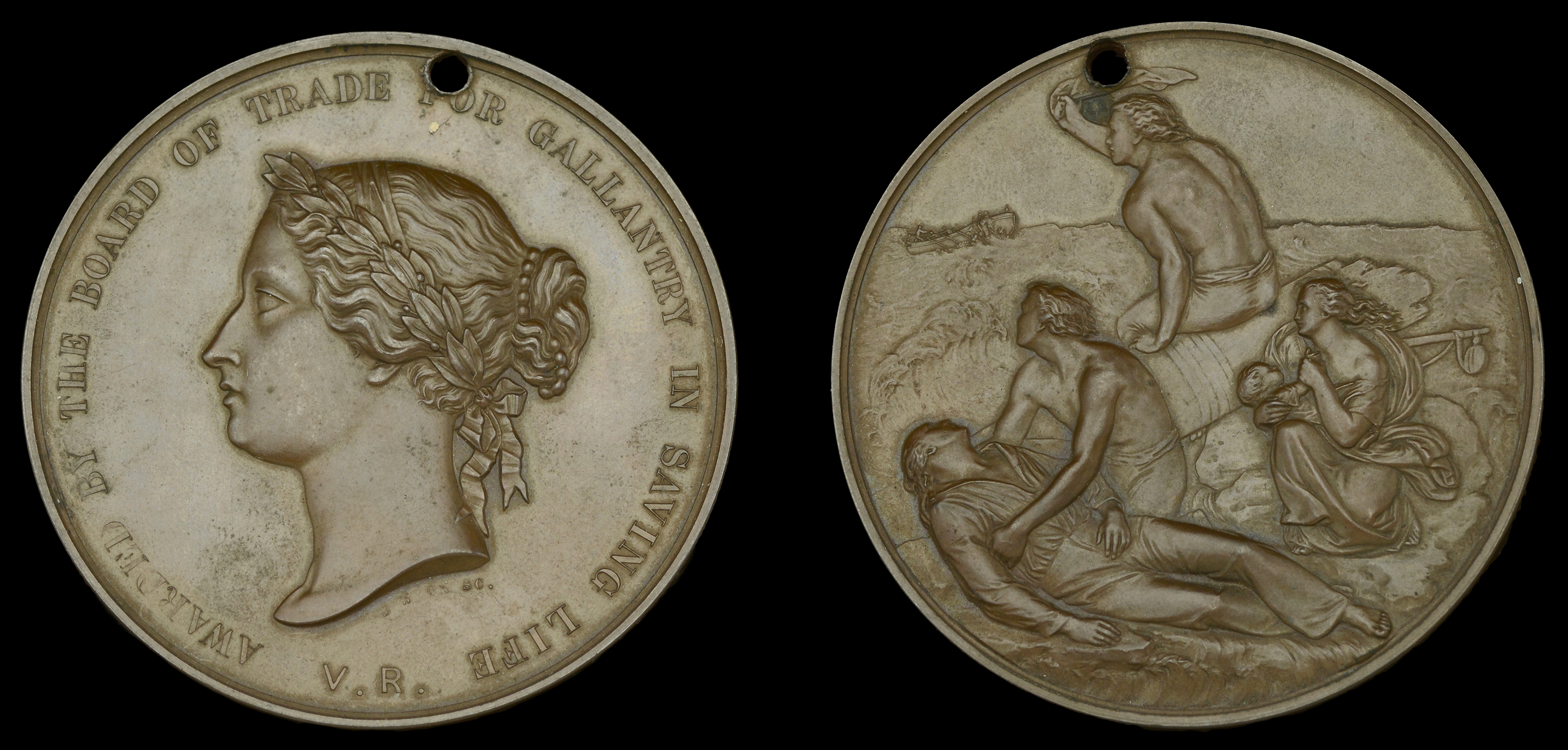747
Board of Trade Medal for Gallantry in Saving Life at Sea, V.R., large, bronze (Thomas E....
Bids do not include VAT, buyer’s premium or delivery.
By confirming your bid, you agree that you have read and accepted the-saleroom.com and the auctioneer's terms and conditions. Confirming your bid is a legally binding obligation to purchase and pay for the lot should your bid be successful.
Choose one of the quick bid options below:
Bids do not include VAT, buyer’s premium or delivery.
By confirming your bid, you agree that you have read and accepted the-saleroom.com and the auctioneer's terms and conditions. Confirming your bid is a legally binding obligation to purchase and pay for the lot should your bid be successful.
---
The Mariner, Captain Hugh Jones, master, left Ramsey on Saturday morning 8th December 1894, bound for Liverpool with a cargo of stones and sand. At the time of her departure a moderate north-northwest breeze was blowing, but this soon fell away to a dead calm, before then increasing and becoming a head wind. All went well until about 4.00 a.m. on Sunday 9th December when the wind increased so much that it prevented the Mariner from reaching the shelter of Holyhead. The ship was then put on a south tack, but the gale increased, whilst the schooner laboured heavily, eventually, at about 3.00 p.m., forcing the crew to take in all the sails and to hove the vessel to. At this stage the Mariner was making water rapidly due to a leak. The crew manfully took to the pumps, but the storm increased in ferocity causing the water to gain quicker than it could be pumped out and then to add to their misery the sand cargo choked the pumps. The crew still had spirit left, and tried to bale out the water, but this proved unsuccessful and the Mariner began to settle down. Just when the crew had given up hope the lights of a passing vessel were observed. Signals of distress were quickly burned.
The steamship Vigilant, of Liverpool, Captain Dean, master, left Silloth on Sunday 9th December bound for Swansea with a cargo of gas coal. At 6.45 p.m. the same evening, when about 27 miles northeast of Holyhead (approximately 21 miles south-southeast of Langness), the crew saw signals of distress exhibited from a vessel, which turned out to be the Mariner. It was blowing a gale from the southeast at the time and a heavy sea was running. Thinking that the lights were only those of fisherman, Captain Dean at first intended going on, but when the signals became more evident, he put back with the intention of effecting a rescue if possible. Despite the extreme and dangerous conditions, volunteers to man the steamer’s lifeboat were not wanting. The volunteers were the Chief Mate Jones, of Liverpool; Thomas Costain, of Port St Mary; a London seaman; and Fred Faragher, of Ramsey. The Vigilant could not approach to close to the distressed schooner because of the heavy seas so the four volunteers launched the lifeboat. The rail was carried away, but undaunted they carried on, managing to pluck the crew of the Mariner from the water. As the shipwrecked sailors were transferred to the Vigilant, the Mariner foundered in the raging sea. The steamer proceeded to Swansea.
The crew of the Mariner was Captain Hugh Jones, of North Wales; John Thomas, mate, of North Wales; William Thompson, seaman, of Whitehaven and seaman Frederick Faragher.
---
The Mariner, Captain Hugh Jones, master, left Ramsey on Saturday morning 8th December 1894, bound for Liverpool with a cargo of stones and sand. At the time of her departure a moderate north-northwest breeze was blowing, but this soon fell away to a dead calm, before then increasing and becoming a head wind. All went well until about 4.00 a.m. on Sunday 9th December when the wind increased so much that it prevented the Mariner from reaching the shelter of Holyhead. The ship was then put on a south tack, but the gale increased, whilst the schooner laboured heavily, eventually, at about 3.00 p.m., forcing the crew to take in all the sails and to hove the vessel to. At this stage the Mariner was making water rapidly due to a leak. The crew manfully took to the pumps, but the storm increased in ferocity causing the water to gain quicker than it could be pumped out and then to add to their misery the sand cargo choked the pumps. The crew still had spirit left, and tried to bale out the water, but this proved unsuccessful and the Mariner began to settle down. Just when the crew had given up hope the lights of a passing vessel were observed. Signals of distress were quickly burned.
The steamship Vigilant, of Liverpool, Captain Dean, master, left Silloth on Sunday 9th December bound for Swansea with a cargo of gas coal. At 6.45 p.m. the same evening, when about 27 miles northeast of Holyhead (approximately 21 miles south-southeast of Langness), the crew saw signals of distress exhibited from a vessel, which turned out to be the Mariner. It was blowing a gale from the southeast at the time and a heavy sea was running. Thinking that the lights were only those of fisherman, Captain Dean at first intended going on, but when the signals became more evident, he put back with the intention of effecting a rescue if possible. Despite the extreme and dangerous conditions, volunteers to man the steamer’s lifeboat were not wanting. The volunteers were the Chief Mate Jones, of Liverpool; Thomas Costain, of Port St Mary; a London seaman; and Fred Faragher, of Ramsey. The Vigilant could not approach to close to the distressed schooner because of the heavy seas so the four volunteers launched the lifeboat. The rail was carried away, but undaunted they carried on, managing to pluck the crew of the Mariner from the water. As the shipwrecked sailors were transferred to the Vigilant, the Mariner foundered in the raging sea. The steamer proceeded to Swansea.
The crew of the Mariner was Captain Hugh Jones, of North Wales; John Thomas, mate, of North Wales; William Thompson, seaman, of Whitehaven and seaman Frederick Faragher.
Orders, Decorations, Medals and Militaria
Sale Date(s)
Venue Address
General delivery information available from the auctioneer
If you are successful in purchasing lot/s being auctioned by us and opt for the item/s to be sent to you, we will use the following methods of shipment:
Within the UK
If you live within the UK, items will be despatched using Royal Mail Special Delivery. This service provides parcel tracking (via the Royal Mail website) and next weekday delivery (betwen 9am and 1pm). Items delivered within the UK are covered by our insurance company. Heavy and bulky lots will be sent by courier, in discussion with the client.
Outside of the UK
If the item/s being sent are worth under £1000 in total they are sent using Royal Mail’s Signed For International service. This ensures the item must be signed for when it is delivered.
If the item/s being sent are valued at over £1000 in total they will be sent using FedEx. This service allows next day delivery to customers in many parts of the US and parcels are fully trackable using the FedEx website.
Shipping Exceptions
Certain lots such as those containing glass or sharp implements, etc., may not be suitable for in-house shipping within or outside of the UK. Please contact Noonans with any queries.
Important Information
Auctioneer's Buyers Premium: 24% (+VAT)
There is an additional charge of 4.95% (+VAT/sales tax)










